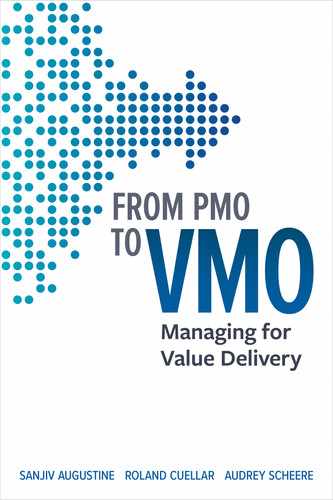When so many enterprises have the strategic goal of maximizing product value to customers, changing their project management office (PMO) into a value management office (VMO) will help them do it.
Because of the widespread adoption of agile methods in organizations, there is a rapidly growing shift from a focus on projects to one on products. This shift brings dramatic changes in how organizations manage and deliver not only IT services but their entire product and service value streams. Whatever methodology is being implemented, success at all levels is inextricably linked back to a clear understanding of customer value and customer-driven outcomes across teams.
This book shows program and project managers how to maximize their professional relevancy in this new world. They must shift from being program managers to value managers, maximizing value through the entire organization. This book defines the role and skills of the value manager, using case studies and step-by-step guidance to help readers visualize and implement a new path where middle management and the value management office are valued leaders in the age of business agility.
Table of Contents
- Cover
- Title Page
- Copyright Page
- Dedication
- Contents
- List of Tables
- List of Figures
- Foreword
- Preface
- 1. Introducing the Agile VMO
- 2. Defining an Agile Process
- 3. Organizing around Value Streams
- 4. Adaptive Planning
- Large-Project Lock-In
- Working the System
- Negative Customer Outcomes
- Conform to Value Rather Than Comply to Plan
- Plan, Deliver, and Measure in Small Batches
- Measure Business Outcomes, Not Stage Outputs
- Sense and Respond to Business Conditions
- Apply Adaptive Planning at Multiple Levels
- Conduct Strategy Planning—Scenario Planning, OKRs, and MMPs
- Conduct Portfolio Planning—Portfolio Kanban
- Conduct Product and Release Planning—Product Road Map and Big Room Planning
- Conduct Sprint/Iteration and Daily Planning
- 5. Tracking and Monitoring Program Flow
- 6. Prioritizing and Selecting MMPs
- 7. Evolving a Funding and Governance Strategy
- Budget, Predictability, and Outcomes
- Flexible Funding: What Will Consumers Value?
- Provide Fixed Funding for Value Streams
- Strategize More Frequently; Annually Is Not Fast Enough
- Monetize at the Feature Level
- Devise a Fixed-Cost Model for Your Stable Agile Teams
- Adopt Business Outcomes as Key Governance Controls
- Utilize a Lean Business Case
- Require Frequent Delivery, and Measure Incremental Business Results
- Recognize That It Is Fundamentally about the Time Value of Money
- 8. Managing Organizational Change
- 9. Setting Up Your Agile VMO
- Create the VMO as a Cross-Functional, Cross-Hierarchy Team of Teams
- Ensure End-to-End Representation with Clear Roles and Responsibilities
- Establish the VMO’s Meetings and Cadence
- Launch the VMO
- Manage the Agile Life Cycle
- Manage the Agile Life Cycle—Getting to Ready
- Manage the Agile Life Cycle—Getting to Done
- Scale Up the VMO to Multiple Levels with an Enterprise VMO
- Notes
- Acknowledgments
- Index
- About the Authors
